It’s not that I am obsessing over my beautiful things and must write an essay about each. (Although I do like good equipment, guilty). BUT! It might be interesting to see what I think about the important parts now, before I’ve actually put them to some action. Might even come back and write an update, how it actually turned out to be. So…
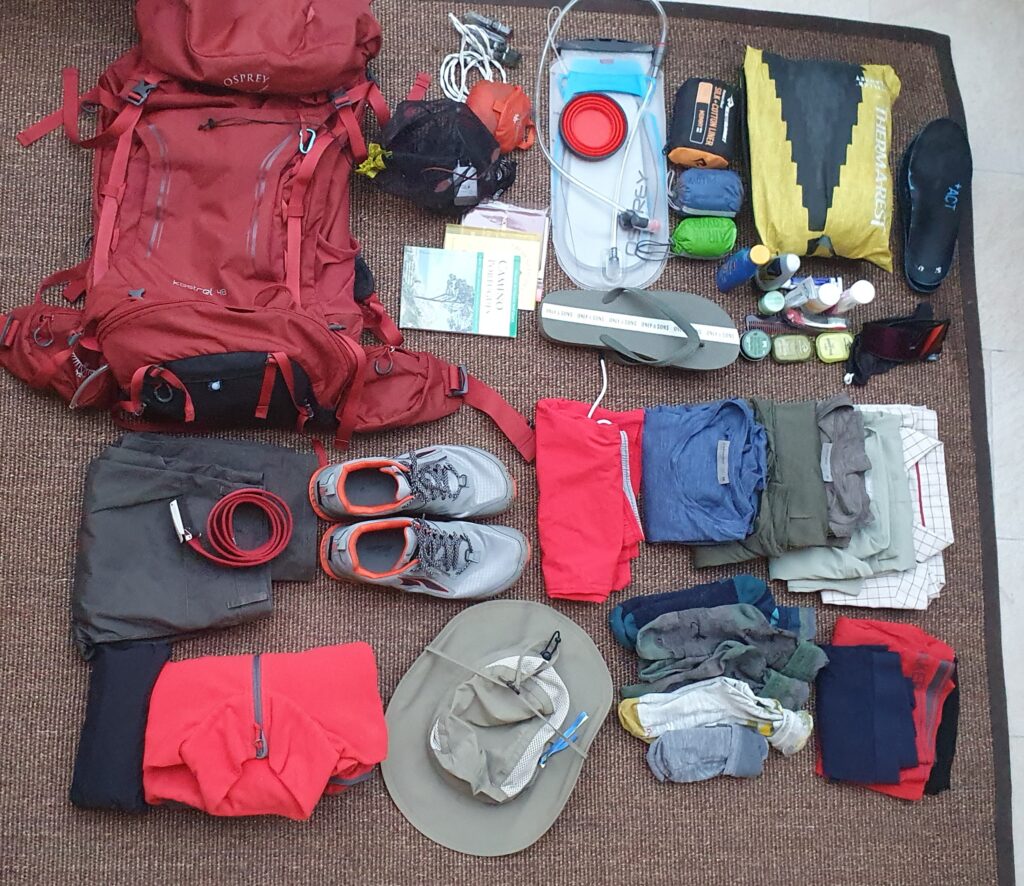
Footwear

Altra Lone Peak 5 is at the top of almost every “best Camino shoes” list. I have zero experience with high temperatures, so from where I am now, I definitely like light and “transparent” shoe. Altra is generally a bit whacky about how large their toebox is and on these I honestly have place for another big toe down there. I’ve been breaking them in during some months now, also with a backpack – seems to not give me much trouble for now.
They are pretty loose around the foot which could be a disaster on a bit more technical trail, but I’m not expecting too much of that on Camino Portuguese, again – remains to be seen. Zero drop, too!
A minus for me is that there doesn’t exist an insole with arch support that would be wide enough for this shoe. I’m still on the fence about carrying an extra pair insoles with me, in case my feet give me so much trouble that I wouldn’t care about uneven edge in front of the shoe.
Update: I think I owe my blister-free trip to those. Extra toe space is important, for me at least. Superb pair for this trip.
Socks
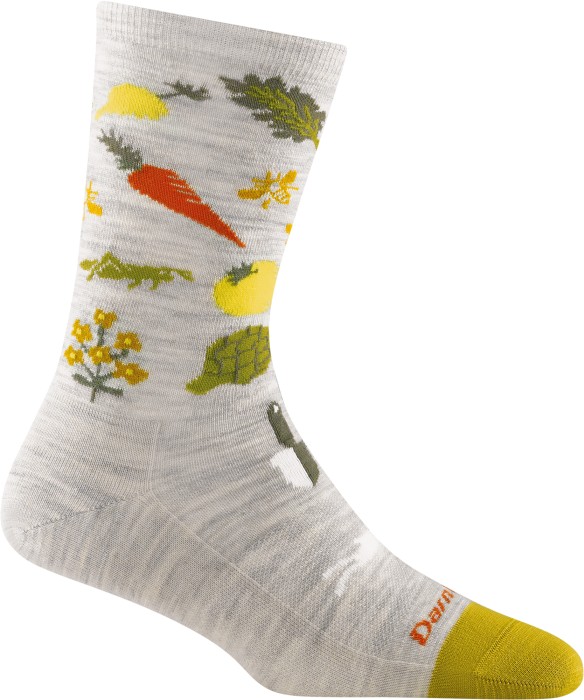
Wool seems like an insane idea in Iberia in July. I am prepared to test it though, since so far everything I’ve read and heard about merino wool’s magic turned out to be true. I have far more pairs of Darn Tough than I care to admit. They are great! It’s a shame they cost like some shoes might cost, but then again, they’re great!
I have some that are padded but I actually wonder if I prefer regular “plain” ones. I think I’ll have 3 or 4 pairs with me this time and see if I need any additional, as they like to put it, “blister management”. Hope there’s nothing to manage.
Update: all of these socks worked very well. I do still prefer plain socks for shorter hikes, but actually I wonder if padded ones were better for me on this longer one. Somehow I always pulled the padded pair from the pack when I prepared for the day.
Luggage
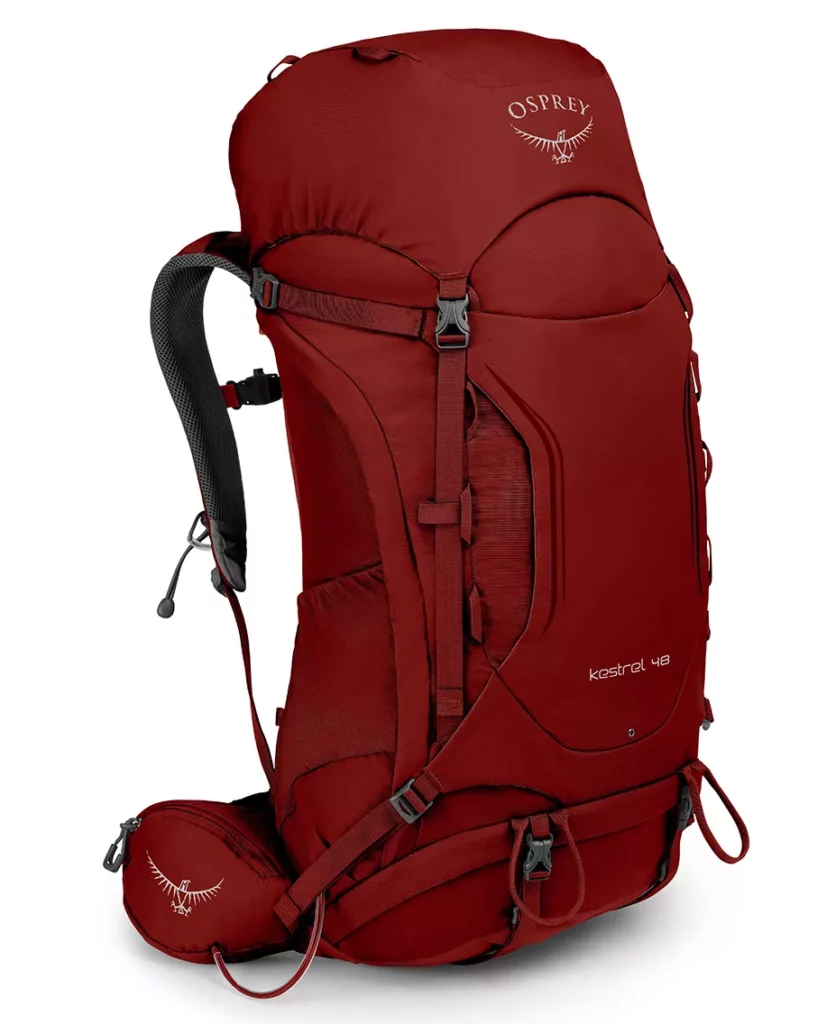 | 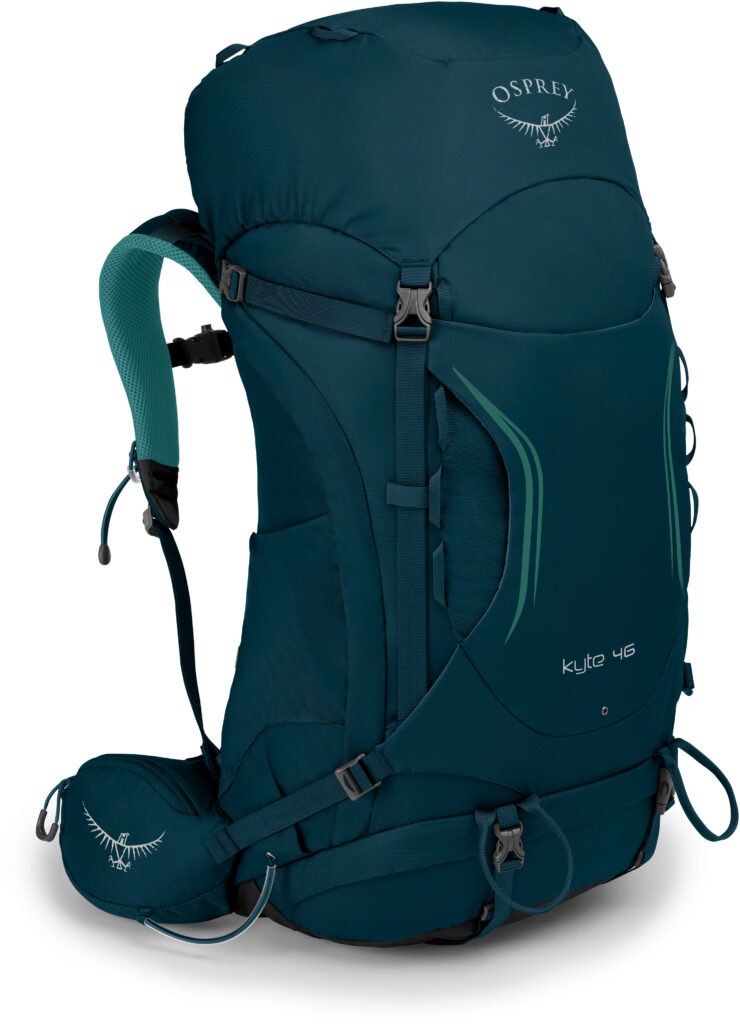 |
These two are obviously the same backpack – a mr. and mrs. Osprey. I got them for us once I started planning the Camino back in 2020 and they are sized specifically for this trip (i.e. not too large). At 48l and 46l they are definitely big enough for it (if not too big) but should you set out to a more autonomous hike (like we did last year on our St.Olavs pilgrimage, 2, 3, 4, 5, 6), you will find yourself wanting for a bigger backpack. Tent gets pushed out to the exterior and then you have problems using the rain cover that comes with the backpack, so it’s a bit clumsy. I use my old Camelbak hydration bladder with it and that one is kind of a pain to shove into the space where it’s supposed to go, between the harness and the bag. I wonder if Osprey’s original hydration system is any easier to put in there – if I find out, I’ll tell you. It might look like that one isn’t supposed to go all the way in. Update: yes, got Osprey’s and used it on a couple of hikes. Definitely easier to get it in, since it has one side reinforced and stiffer than the rest of the bag. Update 2: worked as expected, still good as new, no damages or anything. I liked the size – with a bit extra room, yes, but say you buy lunch to carry with you – always nice to not have to cram it down an already crammed backpack to see the tomatoes squished. Hydration system – better mechanically, but I wonder if Osprey’s puts a bit more of plastic taste into the water than Camelbak does. 3 liters is good size for hot summer.
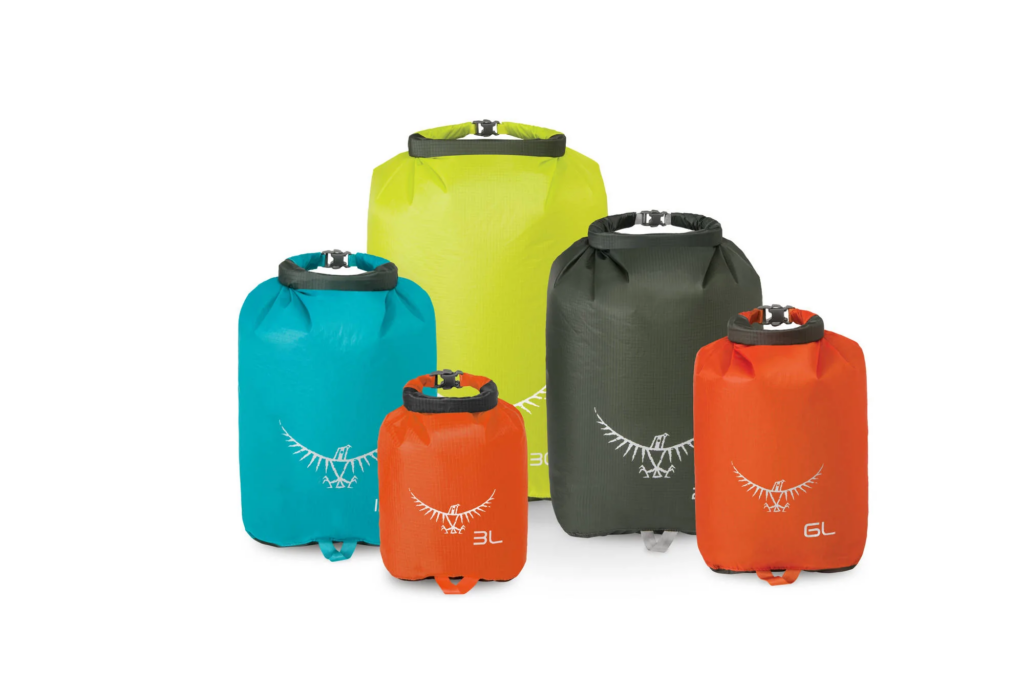
Dry sacks to organize the stuff into. I don’t see much difference between what different brands offer – it’s some Cordura fabric and some locks. Osprey ones were the cheapest for me to get, so that’s what I got.
Update: these are quite important to have if you are staying in albergues, as they are much quieter than regular plastic zip bags that most people seem to have. If there’s anything that might have people wanting to murder you, it’s the ruffle of your little plastic baggie next to their head at 6am when they are trying to sleep. Besides, these are durable, waterproof, airtight (you can almost vacuum-pack your clothes) and easy to coordinate inside your backpack.

So then there’s this little thing. It’s possible we’ll want to leave most of the things wherever we are staying and still have something with us, like beach gear or whatever. It looks like it will work, at least it’s strong and supposedly waterproof. It packs into almost nothing, weighs almost nothing and actually doesn’t cost all that much. Could be good. Update: yes, was good. Used it a lot.
No, Osprey doesn’t pay me for advertisement, they just seem to make good things that cost, well, still a lot, but you know. They are good things.
Pants
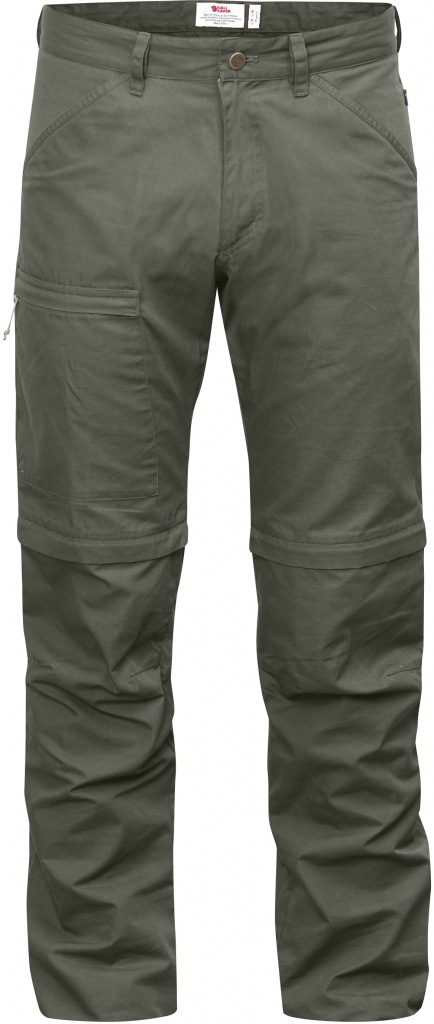
It’s actually surprising how few trekking trousers are made with zip-off configuration. One would think it’s a generally good idea for anybody who is trying to pack light. I’m prepared to be corrected, but I honestly didn’t find many options where I live. Fjällräven was what I ended up with, but the only other option I had was a number from Bergans in stretch fabric which is not something that I like all that much. Besides, that one had so many configurations it almost entirely consisted of zippers.
I have a pair of Fjällräven’s Gaiter Trouser Nr. 1 (which is the only piece of clothing I ever bought second-hand, as the new one costs like 5 pairs of Levi’s) and I like it a lot for almost all of the hiking we do in Norway, but for a warm climate they are definitely too heavy even with the shorts option and with all the ventilation. The High Coast model is made of G-1000 Lite which is even more magical than G-1000. It’s also waxeable, but the material is super thin and light. The whole thing packs very compact, like a thin t-shirt, and the pant legs alone take almost literally no space at all. Another thing I love about them is that they look pretty much as normal leizure pants, being devoid of large cargo pockets or variations in materials and color. Seem strong, too – I used them several times on shorter summer hikes and didn’t have any bad conscience about sitting down anywhere.
Update: dries completely within an hour, at least in warm weather. I sweat a lot and by the end of a day my backside would sometimes look as if my water bag burst. These are very easy to rinse and they are ready to go before you’ve rested a bit after the day’s hike.
Underwear and shirts
Various merino blends for almost everything. I will also carry a couple of very thin nylon shirts. Maybe one too many, but that’s what I am intending to do, at this point. I think nylon would feel cooler. I am kind of cautios about wool in 30+ temperatures. I know what they keep saying – will be happy to update this onece I’ve tried myself.
Update: when we landed in Porto and got out of the terminal, I thought “wow, that was a mistake”. But no, it wasn’t if you consider alternatives. Wool might not feel as cool as, say, light polyester or whatever synthetics they put in technical clothes these days. But it keeps you on very even temperature level and most importantly it is comfortable also when completely soaked from sweat or rain. Imagine a heavy wet cold slab of cotton flapping around your back in the evening breeze. Nothing like that happens with a wool shirt. Boxers simply stay in place. Merino or merino+bamboo washes and dries very easily, also with handsoap or pretty much anything that foams.

The hat doesn’t look very good on me, but it should do better than a cap in terms of covering my face and neck from the sun. Besides, the pilgrim swagger, yo!
Rain gear
Oi-vei, this is the tough one, actually. I see a lot of pilgrims preparing to stand in the middle of an average waterfall, and normally I’d have a Goretex jacket with me. But being influenced by Lidia I might end up taking a light windjacket which has some waterproof quality to it. Maybe I shall let the weather forecast decide for me later on, we’ll see. No rain pants, I guess, either… The backpack has its rain cover and since I am not expecting to carry anything on the outside (besides maybe a large Jamon Iberico?) it should do. Maybe it isn’t very cool to use a cover, but hey, it came with the bag, so. Update: we got one day of rain, on the way from Pontevedra and it was wet, yes. The light windjacket held for maybe half an hour. But no harm done, didn’t get cold. Backpack cover held its own, no surprises there.
Did I forget anything? No trekking poles. Less questions from the airport security and – you know, one has to stand out from the crowd at least somehow 😉 So, no. Update: never missed them either.
General thoughts after the Camino is done
All in all, it helped to carefully research and test stuff. I’m happy with absolute majority of our choices. Also, I’m glad we weren’t shy about investing in good equipment. Was there anything I regretted carrying or not carrying? Well, let’s see.
- Soap sheets and laundry soap sheets from Sea to Summit are not very comfortable to use, especially the laundry ones are shit. A simple small bottle of shower gel or a bar of soap that you can comfortably hold while soaping up your laundry is better.
- Sleeping blanket was kind of controversial as it’s the bulkiest and heaviest piece of luggage. Still glad I had it. All albergues we were staying in were very clean and beds were absolutely nothing to complain about. Still nice to have your own thing between yourself and the single-use linen. Would carry it again. I had also imagined stopping along the way to rest or whatever – never happened. Did use it on a beach one or two times.
- The “nicer” shirts I had with me caused a big stir in the Facebook group. I’m very happy I had them, because going out in the evenings felt miles nicer with a dry and clean shirt with a collar. The ones I had with me were also rather technical ones that worked very well as a light second layer. Not to mention the several “civilian” days we had in Porto, Santiago and Madrid.
- Didn’t need any sleepwear – a pair of cotton boxers I had with me for sleeping is the only thing I never used.
- Battery pack – yes, heavy, but was good to have.
- Note to self: buy train tickets way in advance when in densely populated parts of Europe, especially during holidays and events like Jacobeo.
